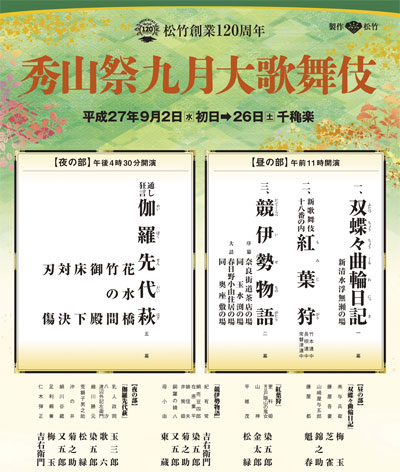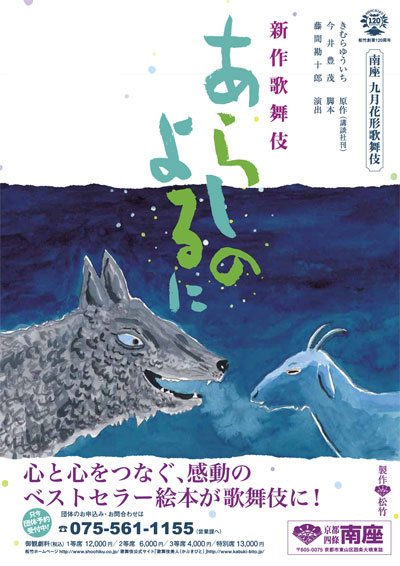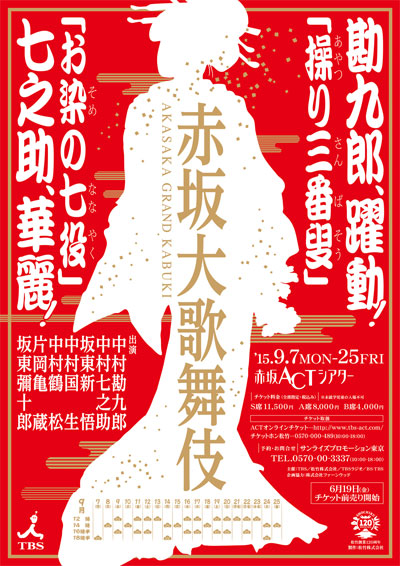| SEPTEMBER 2015 |
| Kabukiza (T˘ky˘) |  |
| Dates | 2 ~ 26 September 2015 (Shűzan Matsuri Kugatsu ďkabuki) Shűzan's Festival September Grand Kabuki |
| MatinÚe | |
| Evening |
|
| Casting |
Living National Treasure Nakamura Kichiemon, Living National Treasure Band˘ Tamasabur˘, Nakamura Baigyoku, Onoe Kikunosuke, Nakamura Shibajaku, Nakamura Kaishun, Nakamura Kinnosuke, Ichikawa Somegor˘, Onoe Sh˘roku, ďtani Tomoemon, Nakamura T˘z˘, Nakamura Karoku, Nakamura Matagor˘, Ichikawa Komaz˘, Kamimura Kichiya, Matsumoto Kingo, Sawamura S˘nosuke, Band˘ Kametoshi, ďtani Keiz˘, Sawamura Yoshijir˘, Nakamura Kamenoj˘, Arashi Kitsusabur˘, Kataoka Matsunosuke, Nakamura Kotar˘, ďtani Hirotar˘, Nakamura Yonekichi, Nakamura Hayato, Nakamura Tanenosuke, Matsumoto Kintar˘, Nakamura Kichinosuke |
| Comments |
The 8th edition in T˘ky˘ of a special program called "Shűzan Matsuri" (the festival of Shűzan) is staged at the Kabukiza to commemorate the great actor Nakamura Kichiemon I, whose's haimy˘ was Shűzan. The star of this program is his adopted son, the Living National Treasure Nakamura Kichiemon II.
The two highlights are the rarely-staged drama "Hade Kurabe Ise Monogatari" and the classic "Meiboku Sendai Hagi" with Living National Treasure Band˘ Tamasabur˘ and Living National Treasure Nakamura Kichiemon in the roles of Masaoka and Nikki Danj˘. "Hade Kurabe Ise Monogatari" was staged only three times since the end of the WWII: in November 1956 and June 1965 at the Kabukiza and in October 2003 at the National Theatre.
|
 |
|
|||
| Dates | 2 ~ 26 September 2015 (Kugatsu Hanagata Kabuki) September Young Actors Kabuki |
||
| Program |
Arashi no Yoru ni |
||
| Casting |
Nakamura Shid˘, Onoe Matsuya, Ichikawa Tsukinosuke, Ichimura Manjir˘, Kawarasaki Gonjűr˘, Nakamura Baishi, Nakamura Mantar˘, Ichimura Takematsu, Ichimura Kitsutar˘ |
||
| Comments |
A newly-created Kabuki drama based on Kimura Yűichi's famous series of illustrated child books "Arashi no Yoru ni" (in English 'One Stormy Night'):
|
||
 |
| Akasaka Act Theater (T˘ky˘) |  |
| Dates | 7 ~ 25 September 2015 (Akasaka ďkabuki) Akasaka Grand Kabuki |
| Program | |
| Casting |
Nakamura Kankur˘, Nakamura Shichinosuke, Band˘ Yajűr˘, Kataoka Kamez˘, Nakamura Tsurumatsu, Band˘ Shingo, Nakamura Kunio |
| Comments |
4th edition of the Akasaka Grand Kabuki, which was started in September 2008 by Nakamura Kanzabur˘ XVIII, the head of the Nakamuraya guild.
|
 |
| Kabuki Tour in the western provinces | |
| Dates | 31 August ~ 25 September 2015 |
| Program | |
| Casting |
Living National Treasure Sakata T˘jűr˘, Nakamura Ganjir˘, Nakamura Senjaku, Ichikawa Sadanji, Ichikawa Omez˘, Nakamura Kikaku, Nakamura Kazutar˘, Nakamura Toranosuke, Nakamura Jűjir˘ |
| Comments |
Nakamura Ganjir˘ IV celebrates his shűmei touring in the western provinces!
|
| Classics Tour | |
| Dates | 4 ~ 27 September 2015 (Koten he no Izanai) Invitation to the Classics |
| Program |
Goaisatsu Ikari Tomomori |
| Casting |
Ichikawa Ebiz˘, Kataoka Ichiz˘, Ichikawa Kudanji, ďtani Hiromatsu, Ichikawa Shinz˘, Ichikawa Shinjűr˘ |
| Comments |
The 4th "Invitation to the Classics" tour led by Ichikawa Ebiz˘ in 14 cities. In "Kusazuribiki", Ichikawa Ebiz˘ and Ichikawa Kudanji play the roles of Soga Gor˘ Tokimune and Maizuru. The third item in this program, "Ikari Tomomori", is a dance-drama based on the "Tokaiya"/"Daimotsu no Ura" scenes of "Yoshitsune Senbon Zakura". Ichikawa Ebiz˘ plays the role of the Heike warrior Taira no Tomomori, with Ichikawa Kudanji and Kataoka Ichiz˘ in the roles of Minamoto no Yoshitsune and Musashib˘ Benkei. The last item in this program is a newly-created dance-drama entitled "Mimasu Kuruwa no Kasauri". It stars Ichikawa Ebiz˘ in the role of an umbrella-seller, in reality the king of thieves Ishikawa Goemon. The opening talk ("Goaisatsu") is done by Ichikawa Ebiz˘. |
|
|||
| Dates | 29 September ~ 4 October 2015 (JAPAN THEATER) | ||
| Program |
Goaisatsu Kagutsuchi no Mai |
||
| Casting |
Ichikawa Ebiz˘, Kataoka Ichiz˘, Ichikawa Kudanji, ďtani Hiromatsu |
||
| Comments |
A special JAPAN THEATER Kabuki program at the Yachiyoza, starring Ichikawa Ebiz˘. |
||
| National Bunraku Theatre (ďsaka) |
| Dates | 2 ~ 9 September 2015 |
| Program | |
| Casting |
Fujikawa Yanosuke, Arashi Yoshisabur˘, Yamazaki Tatsusabur˘, Anegawa Shinnosuke |
| Comments |
A special Zenshinza Kabuki program in ďsaka!
|
|
|||
| Dates | 26 ~ 28 September 2015 | ||
| Program | |||
| Casting |
Fujikawa Yanosuke, Arashi Yoshisabur˘, Yamazaki Tatsusabur˘, Anegawa Shinnosuke |
||
| Comments |
A special Zenshinza Kabuki program in Nagoya!
|
||
| K˘fu Civic Center | |
| Dates | 5 September 2015 (Kish˘ no Kai) |
| Program | |
| Casting |
Ichikawa Kish˘, Ichikawa Ukon |
| Comments |
1st edition of the Kish˘ no Kai (literally "Kish˘'s Association"), which stars Ichikawa Ennosuke's disciple Ichikawa Kish˘, who celebrated his success at the nadai exam in January 2013 in ďsaka at the Sh˘chikuza. The program is staged in K˘fu, the capital of Yamanashi prefecture, at the Arts Hall of the K˘fu Civic Center. |
|
|
| Contact | Main | Top | Updates | Actors | Plays | Playwrights | Programs | Links | FAQ | Glossary | Chronology | Illustrations | Prints | Characters | Derivatives | Theaters | Coming soon | News |